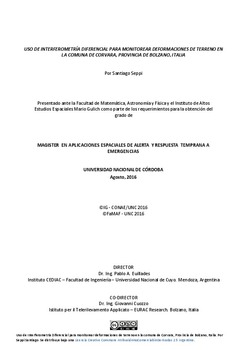| dc.contributor | Cuozzo, Giovanni, co dir. | |
| dc.contributor.advisor | Euillades, Pablo Antonio, dir. | |
| dc.contributor.author | Seppi, Santiago Ariel | |
| dc.date.accessioned | 2018-02-07T15:54:26Z | |
| dc.date.available | 2018-02-07T15:54:26Z | |
| dc.date.issued | 2016-08 | |
| dc.identifier.uri | http://hdl.handle.net/11086/5804 | |
| dc.description | Tesis (Magister en Aplicaciones Espaciales de Alerta y Respuesta Temprana a Emergencias)--Universidad Nacional de Córdoba, Facultad de Matemática, Astronomía, Física y Computación, 2016. | es |
| dc.description | Maestría conjunta con el Instituto de Altos Estudios Espaciales "Mario Gulich"-CONAE. | es |
| dc.description.abstract | El deslizamiento de Corvara (Alpes Italianos) se encuentra activo desde hace más de 10.000 años. Campañas de monitoreo GPS en los últimos 15 años han revelado vectores de deformación de hasta 50 metros para solo un año (Caroli, 2009). Para ese trabajo el deslizamiento de Corvara se toma como caso de estudio para comparar diferentes imágenes SAR y diferentes técnicas para medir deformaciones en el terreno, y para evaluar la factibilidad del procesado interferométrico (InSAR) en estas aplicaciones. Por un lado se prueba el algoritmo Permanent Scatterers (PS) con 27 imágenes Cosmo Skymed en órbita descendente, y por el otro se procesan dos conjuntos de 16 imágenes Sentinel-1A (banda C) en órbita ascendente y descendente con el algoritmo Small Baselines Subset (SBAS). | es |
| dc.description.abstract | The Corvara Landslide (Italian Alps) has been active for over 10,000 years, and systematic ground GPS monitoring within the last 15 years has revealed displacement vectors of up to 50 meters for only one year (Caroli, 2009). In this work the Corvara landslide is taken as case study in order to compare different spaceborne SAR images and techniques to retrieve ground deformation and to evaluate the feasibility of Inteferometry (InSAR) processing for these applications.
On one side the Permanent Scatterers (PS) algorithm is used to process a set of 27 Cosmo Skymed images (X-band) in descending mode acquired over the study area. The presence of 16 artificial Corner Reflectors, designed according to Cosmo Skymed wavelength and acquisition geometry, has been crucial for the implementation of this technique in a rapidly moving and poorly coherent study area.
On the other side two datasets of 16 Sentinel-1A images C-band) in ascending and descending mode are processed with the Small Baselines Subset (SBAS) algorithm, where achieving a coherent
enough combination of interferometric pairs without discarding large portions of data becomes essential.
Both families of algorithms are intended to generate deformation time series and to retrieve parameters such as deformation velocity, terrain height and cumulative displacement. The Corner
Reflectors are also used as ground control points to validate the time series derived from the three datasets. Local environmental factors and sensor characteristics such as the monitored time period, magnitude of the measured movements, difficulties related to X and C band wavelengths and algorithms limitations are analyzed in order to understand the performance of these techniques in a mountainous landslide area like Corvara. | en |
| dc.language.iso | spa | es |
| dc.rights | Atribución-NoComercial-SinDerivadas 2.5 Argentina | * |
| dc.rights.uri | http://creativecommons.org/licenses/by-nc-nd/2.5/ar/ | * |
| dc.subject | Ciencias ambientales | es |
| dc.subject | Environmental sciences | es |
| dc.subject.other | InSAR | |
| dc.subject.other | PS | |
| dc.subject.other | SBAS | |
| dc.subject.other | Banda X | |
| dc.subject.other | Banda C | |
| dc.subject.other | Deslizamientos de terreno | |
| dc.title | Uso de interferometría diferencial para monitorear deformaciones de terreno en la comuna de Corvara, provincia de Bolzano, Italia | es |
| dc.type | masterThesis | es |





